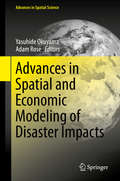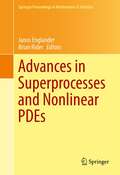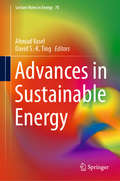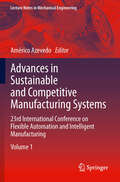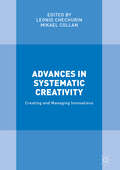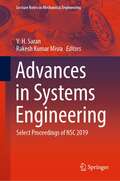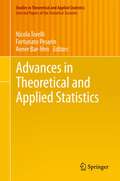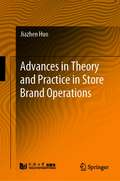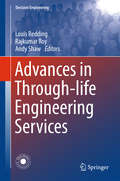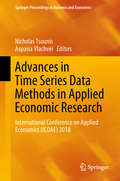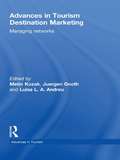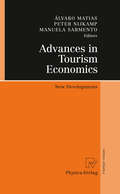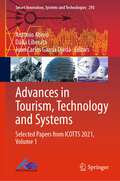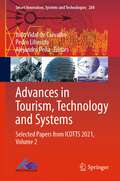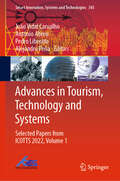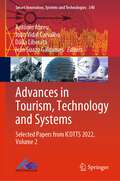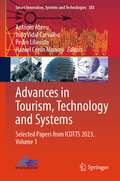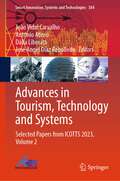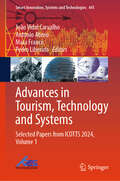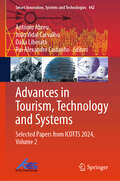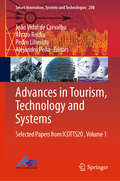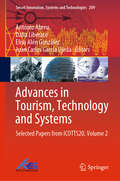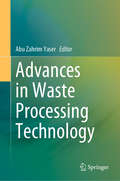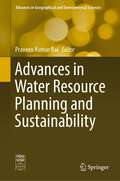- Table View
- List View
Advances in Spatial and Economic Modeling of Disaster Impacts (Advances in Spatial Science)
by Adam Rose Yasuhide OkuyamaThis book presents essential advances in analytical frameworks and tools for modeling the spatial and economic impacts of disasters. In the wake of natural disasters, such as Hurricane Katrina, the Haiti Earthquake, and the East Japan Earthquake and Tsunami, as well as major terrorist attacks, the book analyzes disaster impacts from various perspectives, including resilience, space-time extensions, and decision-making strategies, in order to better understand how and to what extent these events impact economies and societies around the world. The contributing authors are internationally recognized experts from various disciplines, such as economics, geography, planning, regional science, civil engineering, and risk management. Thanks to the insights they provide, the book will benefit not only researchers in these and related fields, but also graduate students, disaster management professionals, and other decision-makers.
Advances in Superprocesses and Nonlinear PDEs (Springer Proceedings in Mathematics & Statistics #38)
by Janos Englander Brian RiderSergei Kuznetsov is one of the top experts on measure valued branching processes (also known as "superprocesses") and their connection to nonlinear partial differential operators. His research interests range from stochastic processes and partial differential equations to mathematical statistics, time series analysis and statistical software; he has over 90 papers published in international research journals. His most well known contribution to probability theory is the "Kuznetsov-measure." A conference honoring his 60th birthday has been organized at Boulder, Colorado in the summer of 2010, with the participation of Sergei Kuznetsov's mentor and major co-author, Eugene Dynkin. The conference focused on topics related to superprocesses, branching diffusions and nonlinear partial differential equations. In particular, connections to the so-called "Kuznetsov-measure" were emphasized. Leading experts in the field as well as young researchers contributed to the conference. The meeting was organized by J. Englander and B. Rider (U. of Colorado).
Advances in Sustainable Energy (Lecture Notes in Energy #70)
by Ahmad Vasel David S-K. TingThis book reveals key challenges to ensuring the secure and sustainable production and use of energy resources, and provides corresponding solutions. It discusses the latest advances in renewable energy generation, and includes studies on climate change and social sustainability. In turn, the book goes beyond theory and describes practical challenges and solutions associated with energy and sustainability. In particular, it addresses: · renewable energy conversion technologies; · transmission, storage and consumption; · green buildings and the green economy; and · waste and recycling. The book presents the current state of knowledge on renewable energy and sustainability, supported by detailed examples and case studies, making it not only a cutting-edge source of information for experts and researchers in the field, but also an educational tool for related undergraduate and graduate courses.
Advances in Sustainable and Competitive Manufacturing Systems: 23rd International Conference on Flexible Automation & Intelligent Manufacturing (Lecture Notes in Mechanical Engineering)
by Américo AzevedoThe proceedings includes the set of revised papers from the 23rd International Conference on Flexible Automation and Intelligent Manufacturing (FAIM 2013). This conference aims to provide an international forum for the exchange of leading edge scientific knowledge and industrial experience regarding the development and integration of the various aspects of Flexible Automation and Intelligent Manufacturing Systems covering the complete life-cycle of a company's Products and Processes. Contents will include topics such as: Product, Process and Factory Integrated Design, Manufacturing Technology and Intelligent Systems, Manufacturing Operations Management and Optimization and Manufacturing Networks and MicroFactories.
Advances in Systematic Creativity: Creating and Managing Innovations
by Mikael Collan Leonid ChechurinThis book presents a collection of the most current research into systemic creativity and TRIZ, engendering discussion and the exchange of new discoveries in the field. With chapters on idea generation, decision making, creativity support tools, artificial intelligence and literature based discovery, it will include a number of instruments of inventive design automation. Consisting of 15-20 chapters written by leading experts in the theory for inventive problem solving (TRIZ) and adjacent fields focused upon heuristics, the contributions will add to the method of inventive design, dialogue with other tools and methods, and teaching creativity in management education through real-life case studies.
Advances in Systems Engineering: Select Proceedings of NSC 2019 (Lecture Notes in Mechanical Engineering)
by V. H. Saran Rakesh Kumar MisraThis book comprises select proceedings of the 43rd National Systems Conference on Innovative and Emerging Trends in Engineering Systems (NSC 2019) held at the Indian Institute of Technology, Roorkee, India. The contents cover latest research in the highly multidisciplinary field of systems engineering, and discusses its various aspects like systems design, dynamics, analysis, modeling and simulation. Some of the topics covered include computing systems, consciousness systems, electrical systems, energy systems, manufacturing systems, mechanical systems, literary systems, social systems, and quantum and nano systems. Given the scope of the contents, this book will be useful for researchers and professionals from diverse engineering and management background.
Advances in Theoretical and Applied Statistics (Studies in Theoretical and Applied Statistics)
by Fortunato Pesarin Avner Bar-Hen Nicola TorelliThis volume includes contributions selected after a double blind review process and presented as a preliminary version at the 45th Meeting of the Italian Statistical Society. The papers provide significant and innovative original contributions and cover a broad range of topics including: statistical theory; methods for time series and spatial data; statistical modeling and data analysis; survey methodology and official statistics; analysis of social, demographic and health data; and economic statistics and econometrics.
Advances in Theory and Practice in Store Brand Operations
by Jiazhen HuoThis book is developed by focusing on the four issues: (1) product strategy of private brand; (2) pricing strategy of private brand; (3) channel strategy with private brand introduction; and (4) supply chain coordination with private brand introduction. Private brand (PB), also known as private label (PL) or store brand (SB), refers to a brand created and controlled by a retailer. In the 1960s and 1970s, private labels began to emerge in France and England. Although private label has grown rapidly worldwide, market share varies greatly from region to region. According to Nielsen's 2018 Global Private Label Report, the largest markets for private-label products are found primarily in the more mature European retail markets. In recent years, many large domestic retail enterprises have launched their own brand products. With the growth of e-commerce, some online retailers have also launched private-label goods. JD started to introduce its private brands in 2010, with annual sales of its private brand products reaching several hundred million yuan. However, at present, the market share of China's private label is only 1-3%, which still has a big gap compared with Europe and America.The main challenges to China's private label lie in private brand operations management. Among them, how to select the correct product categories, how to make pricing decision, how to restructure channels and how to coordinate supply chain after introducing private brands are four operations management problems need to be solved.
Advances in Thermal Engineering, Manufacturing, and Production Management: Select Proceedings of ICTEMA 2020 (Lecture Notes in Mechanical Engineering)
by Santanu Das Sadhan Kumar Ghosh Koushik Ghosh Pranab Kumar Dan Arijit KunduThis book presents the selected peer-reviewed proceedings of the International Conference on Thermal Engineering and Management Advances (ICTEMA 2020). The contents discuss latest research in the areas of thermal engineering, manufacturing engineering, and production management. Some of the topics covered include multiphase fluid flow, turbulent flows, reactive flows, atmospheric flows, combustion and propulsion, computational methods for thermo-fluid arena, micro and nanofluidics, renewable energy and environment sustainability, non-conventional energy resources, energy principles and management, machine dynamics and manufacturing, casting and forming, green manufacturing, production planning and management, quality control and management, and traditional and non-traditional manufacturing. The contents of this book will be useful for students, researchers as well as professionals working in the area of mechanical engineering and allied fields.
Advances in Through-life Engineering Services (Decision Engineering)
by Louis Redding Rajkumar Roy Andy ShawThis edited book offers further advances, new perspectives, and developments from world leaders in the field of through-life engineering services (TES). It builds up on the earlier book by the same authors entitled: "Through-life Engineering Services: Motivation, Theory and Practice. " This compendium introduces and discusses further, the developments in workshop-based and 'in situ' maintenance and support of high-value engineering products, as well as the application of drone technology for autonomous and self-healing product support. The links between 'integrated planning' and planned obsolescence, risk and cost modelling are also examined. The role of data, information, and knowledge management relative to component and system degradation and failure is also presented. This is supported by consideration of the effects upon the maintenance and support decision by the presence of 'No Fault Found' error signals within system data. Further to this the role of diagnostics and prognostics is also discussed. In addition, this text presents the fundamental information required to deliver an effective TES solution/strategy and identification of core technologies. The book contains reference and discussion relative to automotive. rail, and several other industrial case studies to highlight the potential of TES to redefine the product creation and development process. Additionally the role of warranty and service data in the product creation and delivery system is also introduced. This book offers a valuable reference resource for academics, practitioners and students of TES and the associated supporting technologies and business models that underpin whole-life product creation and delivery systems through the harvesting and application of condition and use based data.
Advances in Time Series Data Methods in Applied Economic Research: International Conference On Applied Economics (icoae) 2018 (Springer Proceedings in Business and Economics)
by Nicholas Tsounis Aspasia VlachveiThis conference proceedings volume presents advanced methods in time series estimation models that are applicable various areas of applied economic research such as international economics, macroeconomics, microeconomics, finance economics and agricultural economics. Featuring contributions presented at the 2018 International Conference on Applied Economics (ICOAE) held in Warsaw, Poland, this book presents contemporary research using applied econometric method for analysis as well as country specific studies with potential implications on economic policy. Applied economics is a rapidly growing field of economics that combines economic theory with econometrics to analyse economic problems of the real world usually with economic policy interest. ICOAE is an annual conference started in 2008 with the aim to bring together economists from different fields of applied economic research in order to share methods and ideas. Approximately 150 papers are submitted each year from about 40 countries around the world. The goal of the conference and the enclosed papers is to allow for an exchange of experiences with different applied econometric methods and to promote joint initiatives among well-established economic fields such as finance, agricultural economics, health economics, education economics, international trade theory and management and marketing strategies. Featuring global contributions, this book will be of interest to researchers, academics, professionals and policy makers in the field of applied economics and econometrics.
Advances in Tourism Destination Marketing: Managing Networks (Advances in Tourism)
by Metin Kozak Juergen Gnoth Luisa L. A AndreuThis volume provides original insight into the operational opportunities, challenges and constraints in managing Tourism Destination Marketing. It explores how the various tourist destination systems including tourist, places (as seen by the tourist), public and private tourism organisations and the social and physical environment can effectively communicate and co operate together at a profit for each. Advances in Destination Marketing offers a comprehensive review of a wide range of aspects related to marketing tourism products including networks in destinations, consumer experiences in destinations, destination branding, destination image, events in destinations and destination tourism products. Throughout the book a network analysis perspective is applied to offer alternative solutions of how each system can share network knowledge and system knowledge so profits can be created effectively and maximised. The exploration of new topics such as Destination Networks and Destination Branding as well as original international empirical research and case studies from well known researchers in the area, provides new thinking on Marketing Tourism Destinations. The relevance of the arguments and the salient conclusions are valuable in the study of an ever dynamic and burgeoning industry. This stimulating volume will be of interest to higher level students, academics, researchers within Tourism and practitioners in the industry.
Advances in Tourism Economics: New Developments
by Peter Nijkamp Manuela Sarmento Álvaro Matias'Advances in Tourism Economics' follows his predecessor 'Advances in Modern Tourism Research' (2007) in providing a thorough assessment of state-of-the-art economic research in this rapidly developing field. The authors start by analyzing the recent upsurge of model-based economic research in the field, which builds on powerful tools in quantitative economics, such as discrete choice models, social accounting matrices, data envelopment analyses, impact assessment models or partial computable equilibrium models including environmental externalities. The volume originates from this novel research spirit in the area and aims to offer an attractive collection of operational research tools and approaches. It forms an appealing record of modern tourism economics and positions the field within the strong tradition of quantitative economic research, with due attention for both the demand and supply side of the tourism sector, including technological and logistic advances.
Advances in Tourism, Technology and Systems: Selected Papers from ICOTTS 2021, Volume 1 (Smart Innovation, Systems and Technologies #293)
by António Abreu Dália Liberato Juan Carlos Garcia OjedaThis book features a collection of high-quality research papers presented at the International Conference on Tourism, Technology & Systems (ICOTTS 2021), held at the University of Cartagena, in Cartagena de Indias, Colombia, from 4 to 6 November 2021. The book is divided into two volumes, and it covers the areas of technology in tourism and the tourist experience, generations and technology in tourism, digital marketing applied to tourism and travel, mobile technologies applied to sustainable tourism, information technologies in tourism, digital transformation of tourism business, e-tourism and tourism 2.0, big data and management for travel and tourism, geotagging and tourist mobility, smart destinations, robotics in tourism, and information systems and technologies.
Advances in Tourism, Technology and Systems: Selected Papers from ICOTTS 2021, Volume 2 (Smart Innovation, Systems and Technologies #284)
by Pedro Liberato João Vidal de Carvalho Alejandro PeñaThis book features a collection of high-quality research papers presented at the International Conference on Tourism, Technology & Systems (ICOTTS 2021), held at the University of Cartagena, in Cartagena de Indias, Colombia, from 4 to 6 November 2021. The book is divided into two volumes, and it covers the areas of technology in tourism and the tourist experience, generations and technology in tourism, digital marketing applied to tourism and travel, mobile technologies applied to sustainable tourism, information technologies in tourism, digital transformation of tourism business, e-tourism and tourism 2.0, big data and management for travel and tourism, geotagging and tourist mobility, smart destinations, robotics in tourism, and information systems and technologies.
Advances in Tourism, Technology and Systems: Selected Papers from ICOTTS 2022, Volume 1 (Smart Innovation, Systems and Technologies #345)
by António Abreu Pedro Liberato Alejandro Peña João Vidal CarvalhoThis book features a collection of high-quality research papers presented at the International Conference on Tourism, Technology and Systems (ICOTTS 2022), held at University of Chile, Santiago de Chile, Chile, from 3 to 5 November 2022. The book is divided into two volumes, and it covers the areas of technology in tourism and the tourist experience, generations and technology in tourism, digital marketing applied to tourism and travel, mobile technologies applied to sustainable tourism, information technologies in tourism, digital transformation of tourism business, e-tourism and tourism 2.0, big data and management for travel and tourism, geotagging and tourist mobility, smart destinations, robotics in tourism, and information systems and technologies.
Advances in Tourism, Technology and Systems: Selected Papers from ICOTTS 2022, Volume 2 (Smart Innovation, Systems and Technologies #340)
by António Abreu Dália Liberato João Vidal Carvalho Iván Suazo GaldamesThis book features a collection of high-quality research papers presented at the International Conference on Tourism, Technology and Systems (ICOTTS 2022), held at University of Chile, Santiago de Chile, Chile, from 3 to 5 November 2022. The book is divided into two volumes, and it covers the areas of technology in tourism and the tourist experience, generations and technology in tourism, digital marketing applied to tourism and travel, mobile technologies applied to sustainable tourism, information technologies in tourism, digital transformation of tourism business, e-tourism and tourism 2.0, big data and management for travel and tourism, geotagging and tourist mobility, smart destinations, robotics in tourism, and information systems and technologies.
Advances in Tourism, Technology and Systems: Selected Papers from ICOTTS 2023, Volume 1 (Smart Innovation, Systems and Technologies #383)
by António Abreu Pedro Liberato João Vidal Carvalho Hazael Cerón MonroyThis book features a collection of high-quality research papers presented at the International Conference on Tourism, Technology and Systems (ICOTTS 2023), held at Anáhuac University, Bacalar, Mexico, from 2 to 4 November 2023. The book is divided into two volumes, and it covers the areas of technology in tourism and the tourist experience, generations and technology in tourism, digital marketing applied to tourism and travel, mobile technologies applied to sustainable tourism, information technologies in tourism, digital transformation of tourism business, e-tourism and tourism 2.0, big data and management for travel and tourism, geotagging and tourist mobility, smart destinations, robotics in tourism, and information systems and technologies.
Advances in Tourism, Technology and Systems: Selected Papers from ICOTTS 2023, Volume 2 (Smart Innovation, Systems and Technologies #384)
by António Abreu Dália Liberato João Vidal Carvalho José Angel Díaz RebolledoThis book features a collection of high-quality research papers presented at the International Conference on Tourism, Technology and Systems (ICOTTS 2023), held at Anáhuac University, Bacalar, Mexico, from 2 to 4 November 2023. The book is divided into two volumes, and it covers the areas of technology in tourism and the tourist experience, generations and technology in tourism, digital marketing applied to tourism and travel, mobile technologies applied to sustainable tourism, information technologies in tourism, digital transformation of tourism business, e-tourism and tourism 2.0, big data and management for travel and tourism, geotagging and tourist mobility, smart destinations, robotics in tourism, and information systems and technologies.
Advances in Tourism, Technology and Systems: Selected Papers from ICOTTS 2024, Volume 1 (Smart Innovation, Systems and Technologies #441)
by António Abreu Pedro Liberato João Vidal Carvalho Mara FrancoThis book features a collection of high-quality research papers presented at the International Conference on Tourism, Technology and Systems (ICOTTS 2024), held at held at University of Madeira, Portugal, from 30 to 31 October 2024. The book is divided into two volumes, and it covers the areas of technology in tourism and the tourist experience, generations and technology in tourism, digital marketing applied to tourism and travel, mobile technologies applied to sustainable tourism, information technologies in tourism, digital transformation of tourism business, e-tourism and tourism 2.0, big data and management for travel and tourism, geotagging and tourist mobility, smart destinations, robotics in tourism, and information systems and technologies.
Advances in Tourism, Technology and Systems: Selected Papers from ICOTTS 2024, Volume 2 (Smart Innovation, Systems and Technologies #442)
by António Abreu Dália Liberato João Vidal Carvalho Rui Alexandre CastanhoThis book features a collection of high-quality research papers presented at the International Conference on Tourism, Technology and Systems (ICOTTS 2024), held at held at University of Madeira, Portugal, from 30 to 31 October 2024. The book is divided into two volumes, and it covers the areas of technology in tourism and the tourist experience, generations and technology in tourism, digital marketing applied to tourism and travel, mobile technologies applied to sustainable tourism, information technologies in tourism, digital transformation of tourism business, e-tourism and tourism 2.0, big data and management for travel and tourism, geotagging and tourist mobility, smart destinations, robotics in tourism, and information systems and technologies.
Advances in Tourism, Technology and Systems: Selected Papers from ICOTTS20 , Volume 1 (Smart Innovation, Systems and Technologies #208)
by Álvaro Rocha Pedro Liberato João Vidal de Carvalho Alejandro PeñaThis book features a collection of high-quality research papers presented at the International Conference on Tourism, Technology & Systems (ICOTTS 2020), held at the University of Cartagena, in Cartagena de Indias, Colombia, from 29th to 31st October 2020. The book is divided into two volumes, and it covers the areas of technology in tourism and the tourist experience, generations and technology in tourism, digital marketing applied to tourism and travel, mobile technologies applied to sustainable tourism, information technologies in tourism, digital transformation of tourism business, e-tourism and tourism 2.0, big data and management for travel and tourism, geotagging and tourist mobility, smart destinations, robotics in tourism, and information systems and technologies.
Advances in Tourism, Technology and Systems: Selected Papers from ICOTTS20, Volume 2 (Smart Innovation, Systems and Technologies #209)
by António Abreu Dália Liberato Elisa Alén González Juan Carlos Garcia OjedaThis book features a collection of high-quality research papers presented at the International Conference on Tourism, Technology & Systems (ICOTTS 2020), held at the University of Cartagena, in Cartagena de Indias, Colombia, from 29th to 31st October 2020. The book is divided into two volumes, and it covers the areas of technology in tourism and the tourist experience, generations and technology in tourism, digital marketing applied to tourism and travel, mobile technologies applied to sustainable tourism, information technologies in tourism, digital transformation of tourism business, e-tourism and tourism 2.0, big data and management for travel and tourism, geotagging and tourist mobility, smart destinations, robotics in tourism, and information systems and technologies.
Advances in Waste Processing Technology
by Abu Zahrim YaserThis book highlights the latest research on waste processing technologies, particularly for domestic, agricultural, and petroleum based pollutants, intended to achieve waste valorisation. In addition, it discusses the important role of plastic recycling, as well as advanced waste processing techniques.
Advances in Water Resource Planning and Sustainability (Advances in Geographical and Environmental Sciences)
by Praveen Kumar RaiSustainable water resources planning deals with the interface of water resources science and the needs of human populations. It highlights works that addresses practical methods and basic research in, for example: quantity and quality management of groundwater and surface water resources; sustainability of water resources and water availability; water use and reuse including managed aquifer recharge and storage; geopolitical and socio-economic aspects of water resource management; water development and human activity impacts on ecological systems and human health, including, for instance, agricultural and climatic impacts, subsurface waste storage and injection, geothermal energy development and subsurface energy storage. This book provides up-to-date systematic and scientific analyses of such water problems and suggests sustainable measures to overcome them through effective surface and sub-surface water resource management. It is immensely valuable to students, researchers, water resource managers, hydrologists and all those who are engaged or interested in any aspect of river water conservation and management of water resources.
